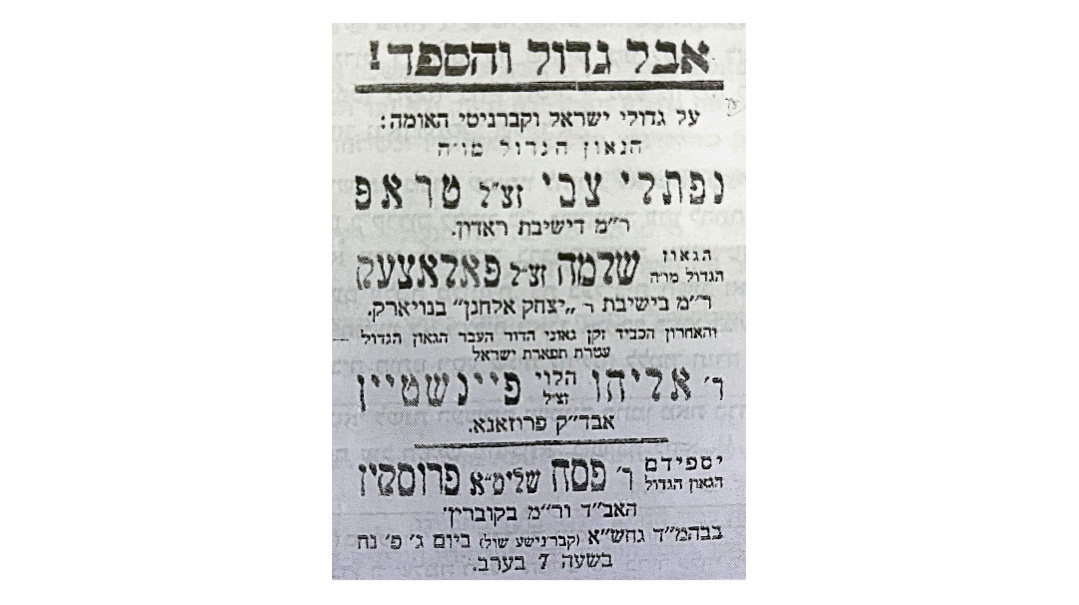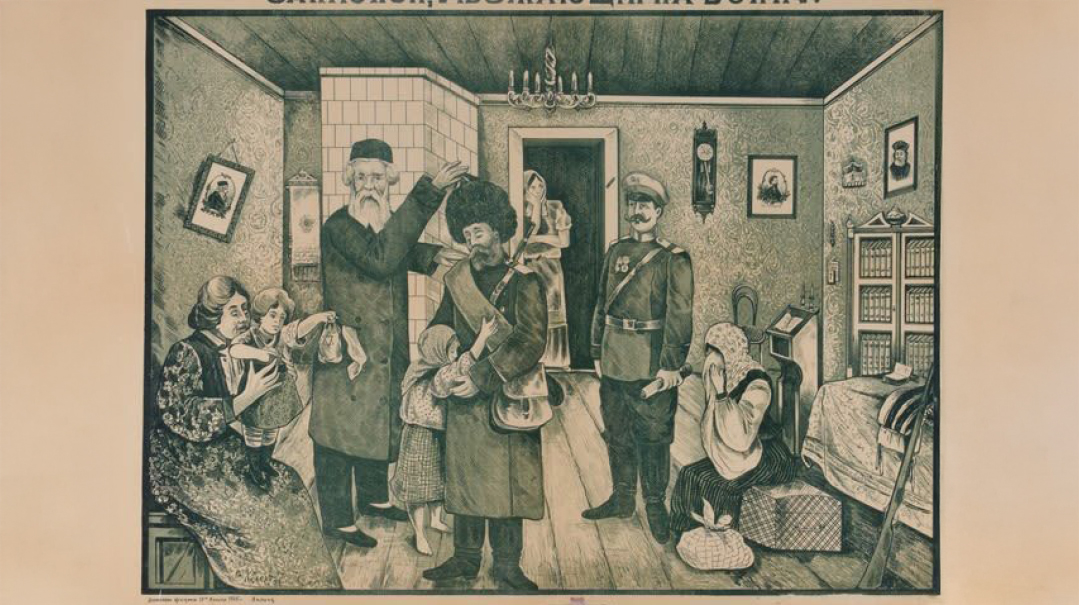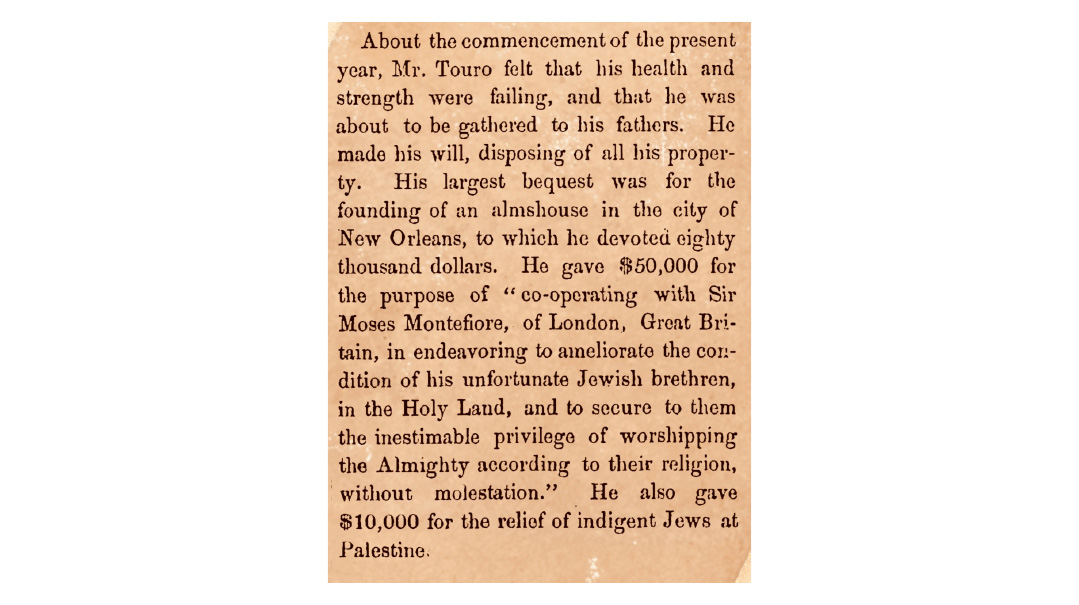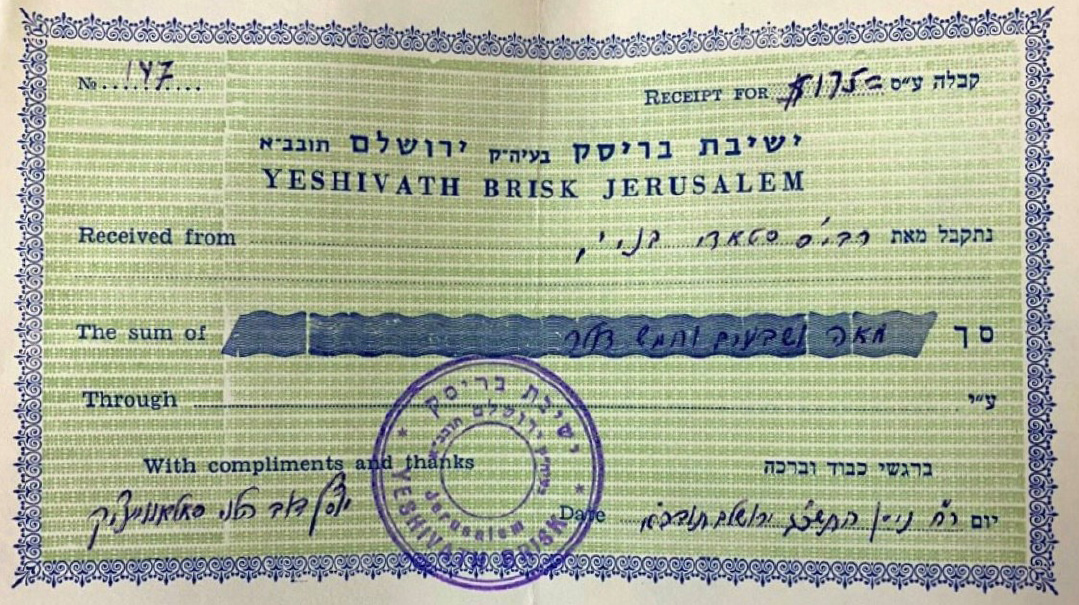The Torah Leadership of Rav Elye Pruzhaner
| May 27, 2025Rav Elye Pruzhaner’s accomplishments demand a place in our collective memory

Title: The Torah Leadership of Rav Elye Pruzhaner
Location: Pruzhany, Belarus
Time: 1929
Document: Poster
IN the heart of the once-vibrant Jewish town of Pruzhany, where the streets once echoed with the sounds of Torah and communal life, stood a great gaon cloaked in profound humility. Rav Eliyahu HaLevi Feinstein (1842–1928), known affectionately as “Rav Elye Pruzhaner,” was a central leader of Russian Jewry of the late 19th and early 20th centuries. He was not merely the rav of Pruzhany; he served as a leader, posek, and activist across the Pale of Settlement during very trying decades of Jewish life under the czars.
His name is less familiar today, perhaps overshadowed by his towering contemporaries in the Russian rabbinate such as Rav Yitzchok Elchonon Spektor, Rav David Karliner, Rav Meir Simcha of Dvinsk, Rav Chaim Ozer Grodzenski, Rav Eliezer Gordon of Telz, and his mechutanim, Rav Eliyahu Chaim Meisel of Lodz and Rav Chaim Soloveitchik of Brisk.
Some of his relatives and descendants also achieved great fame in rabbinical aristocracy and leadership; this may have been another factor in him inadvertently being eclipsed. These include his brother-in-law Rav Yaakov Kantrowitz, who served as a rav in the United States and an early rosh yeshivah of Yeshivah Torah Vodaath; his nephew, the undisputed Torah leader, Rav Moshe Feinstein; his son-in-law Rav Moshe Soloveitchik (and his sons Rav Yosef Dov and Rav Ahron Soloveitchik); and his son-in-law Rav Menachem Krakowski, who served as a rav of various towns in Russia before being hired as a dayan and maggid in Vilna.
Yet Rav Elye Pruzhaner’s accomplishments demand a place in our collective memory. Born in 1842 in the town of Slutzk, Belarus, Rav Eliyahu was the son of Rav Aharon Feinstein, a rosh yeshivah in Slutzk. Even as a child, Eliyahu’s genius astonished the Torah world — he had mastered Seder Nezikin by age seven. Recognizing his brilliance, Rav Yosef Feimar — a close student of Rav Chaim Volozhiner known as Rav Yossele Slutzker, then serving as rav of Slutzk and among the generation’s foremost geonim — took young Eliyahu under his wing, personally guiding him and exposing him to the great Torah luminaries of the time.
At the age of 13, Eliyahu was engaged to Guta, the daughter of Rav Yitzchok Yechiel Davidowitz, the rav of Karelitz. As a gift, he received a copy of Yad Malachi, which he annotated extensively — an early sign of his analytic brilliance. He later entered the famed Volozhin yeshivah, where he became a close student of the Netziv of Volozhin.
Reb Elye married Guta just before his 18th birthday. She was a woman of uncommon kindness and organizational prowess. While he was immersed in learning, she built institutions for the poor, raised dowries for orphaned brides, and even moved misers to give with a smile. Her devotion complemented his, forming a rare partnership of Torah and chesed.
After the passing of his father in 1863, the townspeople of Storobin urged the young prodigy to assume the rabbanus of this small White Russian town. Reluctant, he agreed on one condition: that every day until noon be reserved for undisturbed Torah study, and only after that would he attend to communal responsibilities. Until his final days, Rav Elye maintained this sacred commitment — wrapped in tallis and tefillin, sustained by water and a cup of milk after Shacharis, fully immersed in the sea of Talmud.
He later was appointed as rabbi of Kletzk in 1870, followed by stints in Karelitz and Chaslevitch, but his terms were always the same: half a day of unfettered Torah study. He viewed his learning not as a privilege, but as a sacred duty — one that could not be compromised, even for the most prominent pulpits.
While Rav Elye yearned for a life of peace and quiet, history had other plans, and he’d soon be thrust onto the grand stage of Russian Jewish history. The czarist Russian military draft was brutally unjust. Wealthy families protected their sons while orphans and the poor were seized. Rav Elye confronted this challenging reality with wisdom and unflinching justice. He battled corrupt landowners, invoking Torah and morality in defense of the powerless. Other rabbanim soon followed his lead, and a new model of rabbinic courage was born.
Later, in his subsequent rabbinic positions and eventually in Pruzhany, Rav Elye became the savior of young men facing illegal conscription and the silent spiritual threat posed by migration beyond the Pale of Settlement. Recognizing the risks of assimilation, he maneuvered government channels to secure legal permits for rabbanim, shochtim, and melamdim to serve Jews in these distant places, ensuring the flame of Yiddishkeit did not flicker out in spiritual deserts.
Twice in his life, Rav Elye stood at the crossroads of Jewish history — at two historic conferences of Torah leaders in St. Petersburg. At the 1882 congress, in the wake of devastating pogroms, most rabbanim called for a diplomatic appeal to the czar. Rav Elye stood alone, warning that the persecution bore the czar’s full endorsement. Sadly, he was right.
At the more famous 1910 convention, he lobbied for the acceptance of limited educational reforms: improving the quality of cheder and yeshivah education, and cautiously accepting government-mandated general subjects, limited in scope, into the curriculum. Though criticized by many of his rabbinical peers, he felt that the czarist pressure was best accepted in a limited fashion, thus preventing the entire edifice of Torah education from falling by the wayside due to the continuous onslaught from various quarters. This concession would enable continued rabbinical oversight over the cheder system and overall maintenance of the status quo in traditional Torah education.
In 1884, Rav Eliyahu accepted the rabbanus of Pruzhany, filling the position vacated by Rav Yerucham Yehuda Leib Perlman, who had been hired as rabbi of Minsk and would hence be known as the “Minsker Gadol.” Again, his contract stipulated half-days for learning. But when calamity struck, the talmid chacham became the community’s first responder.
When a cholera epidemic devastated the Polesie region where Pruzhany is located, Rav Elye left his study to lead relief efforts. He visited the sick, established public kitchens, and ensured no one went hungry. He even arranged for the wealthy to donate discreetly rather than pay for their meals, sparing the poor embarrassment. When a chevra kaddisha refused to handle a cholera victim’s burial, Rav Elye closed all shuls and declared the mitzvah his alone. Only after personally overseeing the taharah and burial did he reopen the shuls. From that day forward, not one more death from cholera was recorded in Pruzhany.
He continued at the helm of Pruzhany during the mayhem of World War I, the Bolshevik Revolution, the Russian Civil War, and finally the Polish-Soviet War. Though the city eventually ended up on the side of the Second Polish Republic, it was briefly occupied by the Bolsheviks in 1920. The Bolsheviks began drafting young men into the Red Army, and local parents rushed to Rav Elye for advice. The draft board, suspicious, placed his house under surveillance. Warned of his imminent arrest, he refused to close his door.
“One does not shut the door on those seeking help,” he said.
Miraculously, the danger passed when the Polish army liberated the town the next morning.
In the late 1920s, Pruzhany was ravaged by a fire while Rav Elye was abroad undergoing medical treatment for a stomach ulcer. He rushed home despite doctors’ protests. When the Polish government’s proffered aid was minimal, Rav Elye Pruzhaner utilized his well-honed diplomatic skills and brokered a creative deal: He asked the regional governor to waive tariffs on building materials sent to Pruzhany. The exemption turned Pruzhany into a hub of reconstruction, saving the town and its people. Even non-Jews credited him.
“We owe him our well-being,” they said.
Rav Elye thus proved that rabbinic leadership meant taking initiative well beyond the confines of the beis din and even of assisting individuals. A rabbi’s leadership meant going the full measure in seeking out the community’s physical and spiritual welfare, engaging with government officials, and submitting economic proposals.
Rav Eliyahu passed away on the 27th of Tishrei, 1928, at age 85, after a long and fruitful rabbinical career. Eulogies poured in from across Europe and Eretz Yisrael. Rav Yosef Chaim Sonnenfeld expressed deep sorrow that Rav Eliyahu had been prevented from accepting the chief rabbinate of Yerushalayim — twice.
“Had we merited,” he said, “the face of the Yishuv would have been transformed.”
His many illustrious descendants and the publication of his Torah work Halichos Eliyahu constitute his concrete and eternal legacy. Though he left no titles, no institutions bearing his name, no monument carved in stone, in the broader story of Russian Jewry and its Torah leadership during a challenging period, Rav Elye Pruzhaner’s story stands as a beacon of light.
This column is based on the research and writings of Dr. Anna Krakovski.
(Originally featured in Mishpacha, Issue 1063)
Oops! We could not locate your form.






